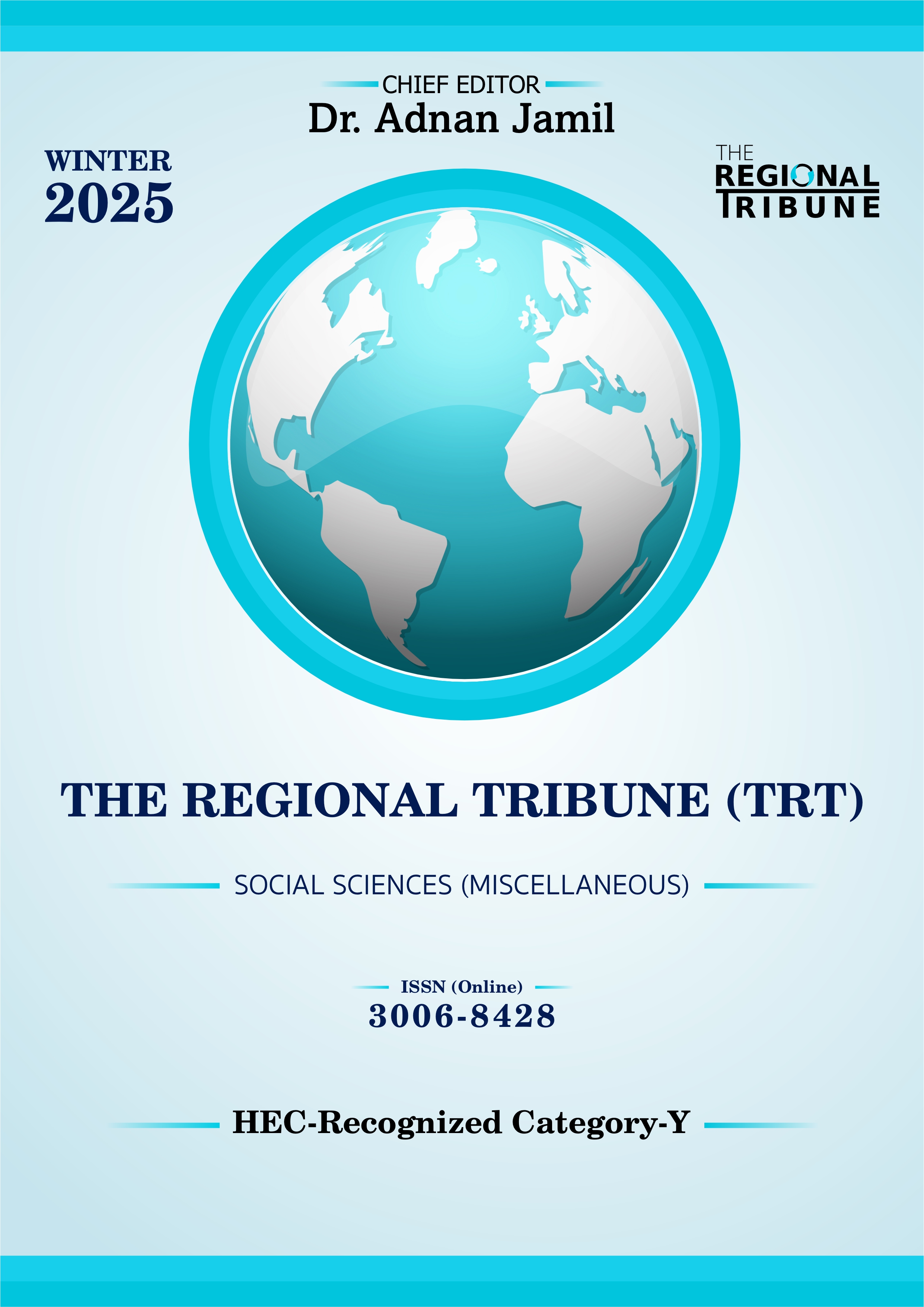Workplace Diversity Management for Strengthening Organizational Commitment and Minimizing Discrimination Perception: The Mediating Role of Inclusive Climate
DOI:
https://doi.org/10.55737/trt/WR25.099Keywords:
Organizational Commitment, Workplace Diversity, Discrimination Perceptions, Inclusive ClimateAbstract
Diverse nursing teams can elevate care quality, yet unmanaged differences may erode morale and foster perceptions of discrimination. This study investigates how workplace diversity management (WD) practices influence nurses’ organizational commitment (OC) and discrimination perception (DP) in Sukkur’s teaching hospitals, and whether an inclusive climate (IC) mediates these relationships. A proportionate stratified sample of 238 staff nurses completed validated measures of WD, IC, OC, and DP. Data were analysed with SmartPLS 4, using a two-stage approach that confirmed construct reliability and validity before bootstrapping structural paths (5,000 resamples). WD positively predicted OC (β = 0.40, p < .001) and negatively predicted DP (β = –0.32, p < .001). WD also exerted a strong effect on IC (β = 0.57), which in turn enhanced commitment (β = 0.33) and reduced discrimination perception (β = –0.28). Significant indirect effects (WD → IC → OC: β = 0.19; WD → IC → DP: β = –0.16) confirmed partial mediation. The model explained 48 % of variance in OC and 40 % in DP, underscoring IC as a key psychological mechanism translating structural diversity efforts into favourable attitudes. Findings highlight the need for visible, consistently enforced diversity policies and leader behaviours that nurture inclusion to retain committed nursing staff and curb discrimination in resource-constrained healthcare settings.
References
Adedeji, O. (2019). The Effect of Age Related HR Practices on Perceived Age Discrimination, Employee Commitment, Turnover Intentions and The Moderating Effect of Diversity Management. A Survey Investigation in Nigerian Banks (Doctoral dissertation, University of Huddersfield).
Chalise, S. (2024). Diversity signal sets: implications for organizations and individuals (Doctoral dissertation, Memorial University of Newfoundland).
Cox, T. H. (1993). Cultural diversity in organizations: Theory, research, and practice. Berrett-Koehler.
Cropanzano, R., & Mitchell, M. S. (2005). Social exchange theory: An interdisciplinary review. Journal of Management, 31(6), 874–900. https://doi.org/10.1177/0149206305279602
Desivilya, H., & Raz, M. (2015). Managing diversity and social divisions in nurses’ work teams. EuroMed Journal of Business, 10(2), 264-278. https://doi.org/10.1108/EMJB-08-2014-0024
Ferdman, B. M., & Deane, B. R. (Eds.). (2014). Diversity at work: The practice of inclusion. Jossey-Bass.
Fiest, K. M., McIntosh, C. J., Demiantschuk, D., Leigh, J. P., & Stelfox, H. T. (2018). Translating evidence to patient care through caregivers: a systematic review of caregiver-mediated interventions. BMC medicine, 16, 1-10. https://doi.org/10.1186/s12916-018-1097-4
Gonzalez, J. A., & DeNisi, A. S. (2009). Cross-level effects of demography and diversity climate on organizational attachment and firm effectiveness. Journal of Organizational Behavior, 30(1), 21–40. https://doi.org/10.1002/job.498
Hair Jr, J. F., Hult, G. T. M., Ringle, C. M., Sarstedt, M., Danks, N. P., & Ray, S. (2021). Partial least squares structural equation modeling (PLS-SEM) using R: A workbook (p. 197). Springer Nature
Holm, O., & Torkildsen, T. K. (2020). Inclusive leadership and perceived inclusion climate in hospital units: Implications for nurse commitment. Journal of Nursing Management, 28(6), 1300–1309. https://doi.org/10.1111/jonm.13121
Krejcie, R. V., & Morgan, D. W. (1970). Determining sample size for research activities. Educational and psychological measurement, 30(3), 607-610. https://journals.sagepub.com/doi/abs/10.1177/001316447003000308#tab-contributors
Li, J., & Jones, C. B. (2013). Perceived discrimination and its correlates among hospital nurses in China. Journal of Nursing Scholarship, 45(2), 192–200. https://doi.org/10.1111/jnu.12018
Meyer, J. P., Stanley, D. J., Herscovitch, L., & Topolnytsky, L. (2002). Affective, continuance, and normative commitment to the organization: A meta-analysis of antecedents, correlates, and consequences. Journal of Vocational Behavior, 61(1), 20–52. https://doi.org/10.1006/jvbe.2001.1842
Ministry of National Health Services. (2023). Nursing workforce strategic plan 2023–2028. Government of Pakistan.
Moon, K.-K., & Christensen, R. K. (2022). Moderating diversity, collective commitment, and discrimination: The role of ethical leaders in the public sector. Journal of Public Administration Research and Theory: J-PART, 32(2), 380–397. https://doi.org/10.1093/jopart/muab035
Mor Barak, M. E., Cherin, D. A., & Berkman, S. (1998). Organizational and personal dimensions in diversity climate. Journal of Applied Behavioral Science, 34(1), 82–104. https://doi.org/10.1177/0021886398341006
Nachmias, S., Mitsakis, F., Aravopoulou, E., Rees, C. J., & Kouki, A. (2022). Line managers’ perceptions of diversity management: insights from a social exchange theory perspective. Employee Relations, 44(2), 294–318. https://doi.org/10.1108/er-12-2019-0484
Nishii, L. H. (2013). The benefits of climate for inclusion for gender‐diverse groups. Academy of Management Journal, 56(6), 1754–1774. https://doi.org/10.5465/amj.2009.0823
Olsen, J. E., & Martins, L. L. (2012). Understanding organizational diversity management programs: A theoretical framework and directions for future research. Journal of Organizational Behavior, 33(8), 1168–1187. https://doi.org/10.1002/job.1792
Roberson, Q. M. (2006). Disentangling the meanings of diversity and inclusion in organizations. Group & Organization Management, 31(2), 212–236. https://doi.org/10.1177/1059601104273064
Sabharwal, M. (2014). Is diversity management sufficient? Organizational inclusion to further performance. Public Personnel Management, 43(2), 197–217. https://doi.org/10.1177/0091026014522202
Shore, L. M., Cleveland, J. N., & Sanchez, D. (2018). Inclusive workplaces: A review and model. Human Resource Management Review, 28(2), 176–189. https://doi.org/10.1016/j.hrmr.2017.07.003
Shore, L. M., Randel, A. E., Chung, B. G., Dean, M. A., Ehrhart, K. H., & Singh, G. (2011). Inclusion and diversity in work groups: A review and model for future research. Journal of Management, 37(4), 1262–1289. https://doi.org/10.1177/0149206310385943
World Health Organization. (2022). State of the world’s nursing 2022: Investing in education, jobs and leadership. WHO.
Downloads
Published
Issue
Section
License

This work is licensed under a Creative Commons Attribution-NonCommercial 4.0 International License.



